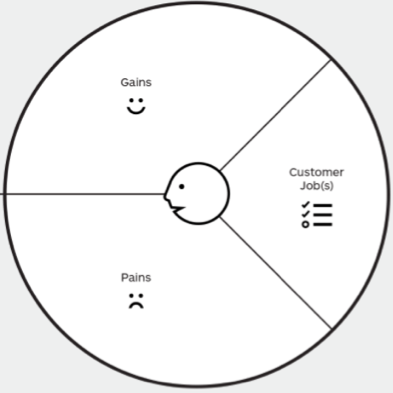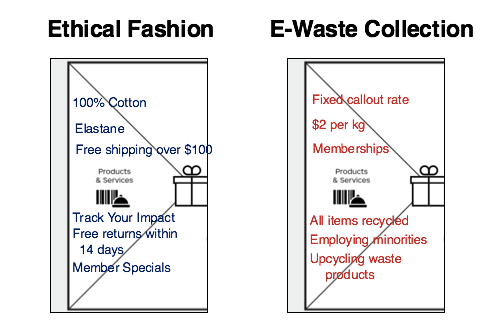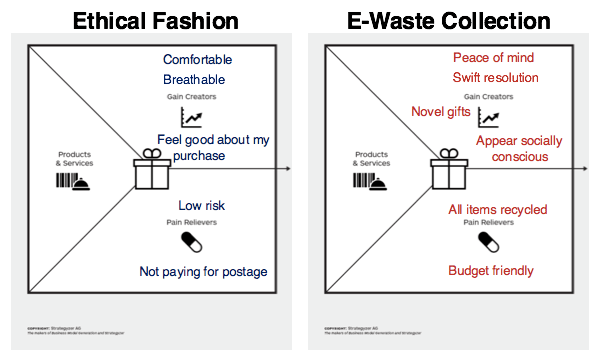How To Fill In A Value Proposition Canvas
For a free template, go to Strategyzer.com
(If you’re crafting Value Propositions, you’ll love my free Value Propositions eBook, full of tips for designing and testing compelling Value Propositions that will delight your customers.)
The Value Proposition Canvas is a great tool for understanding how customers make decisions, and therefore helps us create offers that they will find appealing.
The best way to get started is to see someone else using it.
This shows you how to observe your customers, design your offers, and predict which value propositions will best delight your audience.
Let’s look at how two entrepreneurs fill in the canvas.
We’ll look at a product business selling ethical made clothing, and a service business that collects e-waste from corporate offices.
You can do the same – grab a template or a sheet of paper, and fill one in for your customers at the same time.
The Customer Canvas
Our customers aren’t robots, they’re real people who make fast, instinctive decisions.
They don’t have time to do lots of research – they just want to solve the problems they face day to day.
The customer canvas paints a more detailed picture.
First we’ll look at their Jobs To Be Done, which define what’s on our customer’s mind right now.
Secondly, we’ll look at the Gains & Pains – the positive and negative states our customers want to attain/avoid.
These might not seem rational, but they’re very powerful in decision making.
Our ethical fashion customer is Hannah, a 28-year-old photographer.
Our e-waste removal customer is Silvio, a 52-year-old facilities manager.
Jobs To Be Done
Here we look at three types of jobs: Functional, Social and Emotional
Functional jobs are practical considerations, usually quite mundane and straightforward.
Social jobs are driven by a sense of duty, optimism, fear or aspiration – the things we feel we have to do as part of our role in relationships and society.
Emotional jobs come from our preferences, likes and dislikes, insecurities and indulgences.
Hannah is shopping for new clothes.
She needs items that can be worn at work – so they have to look professional.
She’s sick of hand-washing clothes, but also doesn’t want to spend too much on dry cleaning.
She hates the idea of “Fast Fashion”, having watched a documentary on the environmental impacts of manufacturing.
She wants her clothes to make her feel confident, that they flatter her figure but aren’t too revealing.
Her favourite colours are pastels, and she has an aversion to details like beads and embellishment that jingle when she walks.
Silvio has been tasked with clearing out the remaining computers and photocopiers left over from a former tenant of his office building.
There’s far too much for their usual waste collection, and some of these items seem like they can’t be put in a regular bin.
He’s pushed for time as is, and doesn’t want to have to monitor several people.
He can’t stand to see this technology wasted, and feels a responsibility for contributing so much to landfill.
He also has budget pressures, and needs to justify all decisions with the CFO.
From this, we can begin to map out the main jobs for each of our customers.
Not everything makes the cut, and we can always add more detail after talking with more customers.
Gains and Pains
Now we’re looking to understand the preferences and attitudes that shape our customers purchasing decisions.
We don’t have to agree with them, we just map what they are today.
Hannah loves shopping online, without pushy retail assistants, teenagers and loud music.
She wants to be able to easily return items that don’t fit, and hates paying for shipping to Australia.
Versatility is really valuable, because it means she can wear her favourite items in a range of outfits.
She won’t overpay for a designer label, and has an eye for quality.
She wants to feel that what she buys can make a difference in the world, and loves having people ask her about where she bought her clothes.
Her taste is well regarded amongst her friends, and she’d like to keep that reputation.
Silvio wants to make one call and have everything sorted, and wants all the items collected by this Friday.
He wants to make sure that everything is disposed of properly – partly because it’s the right thing to do, partly because he doesn’t want the company to get any negative publicity for breaking the law.
He doesn’t want to overpay, so whoever he goes with needs to be priced similarly to their usual garbage company.
Silvio’s company pride themselves on being responsible corporate citizens, and want to show their customers that they aren’t heartless landlords.
Now we’re getting a clearer picture of our customers and their thought processes.
It seems that they don’t have a particular product or service in mind, but rather a series of principles that guide their decision making
e.g. Is this convenient?
Am I getting a good price?
Does this match my worldview?
Does this fit with my reputation?
The Product Canvas
Having explored our customers and their motivations, we can get creative with how we describe our Product and Service Features.
We can tailor our advertising to highlight the most relevant and interesting parts of what we sell, called Gain Creators and Pain Relievers, which gives us the best possible chance of making a sale.
Product and Service Features
This is the place to list all the things that we’re literally selling – like when car companies talk about airbags, leather seats and extended warranties.
For our ethical fashion company, we’re offering:
· 100% cotton dresses
· Jeans with 2% elastane
· Free shipping with orders over $100
· Track Your Impact, allowing you to see where your clothes were made
· Free returns within 14 days
· Member specials and VIP discounts
For our e-waste removal, we’re offering:
· A fixed callout rate for metropolitan areas
· $2 per kg for the first 300kg collected, $2.50 per kg for additional collections
· $500 per year memberships, with flat rates of $1.50 per kg for all collections
· Guaranteed recycling of all electronic components
· Employment of asylum seekers
· Employment of people with disabilities
· Upcycling of old letterhead and computer keyboards
Gain Creators and Pain Relievers
The question is – so what?
Why do these features mean anything?
We need to frame them as being valuable to our customer, either as Gain Creators that offer them something new, or as Pain Relievers that remove a current frustration.
For our fashion company, their clothes are made of the highest quality fabrics, which are comfortable and breathable.
The risk of buying online is greatly reduced, so customers can take a chance on something new without obligation to keep it if it doesn’t fit.
The impact tracker allows customers to feel great about their purchase, and also tell an interesting story to their friends about where their clothes come from.
For our waste collectors, customers know can rest assured that their old machinery has been properly recycled.
They can advertise themselves as being environmentally friendly, both to their staff and to their customers.
They can also feel good about employing people from marginalised backgrounds.
Upcycled products make great gifts for staff and customers, and are an interesting conversation starter around the office.
So now we have filled in both parts of the Canvas – what does it tell us?
Firstly, we can see a good alignment with our customers – there is obvious overlap between when they want and what we sell.
Secondly, there’s room for improvement.
Hannah is going to have questions and concerns that aren’t able to be answered – like how the garment quality stacks up to other brands.
Yes, she’ll love the story, but not if she feels like she’s overpaying.
Silvio will appreciate the environmental impact of the e-waste collectors, but doesn’t understand if this is cheap or expensive.
How much more/less is this that what he’d pay elsewhere?
And when can they collect from his office?
If it can’t be done in the next few days, he’s going to have to go with someone else.
Thirdly, there needs to be some more validation of critical assumptions.
Are Hannah and Silvio accurate representations of the broader market?
How much are they willing to pay?
What are their dealbreakers?
How often will they come back?
How will we get in touch with more people like them?
Try it for yourself: Fill in a canvas and see where there are gaps.
You can use this uncertainty as fuel – run more experiments, ask more questions, try out new ideas.
By understanding your customers’ preferences, biases and thoughts, you’ll find new ways to delight them and grow your business.
If you’re crafting Value Propositions, you’ll love my free Value Propositions eBook, full of tips for designing and testing compelling Value Propositions that will delight your customers.















